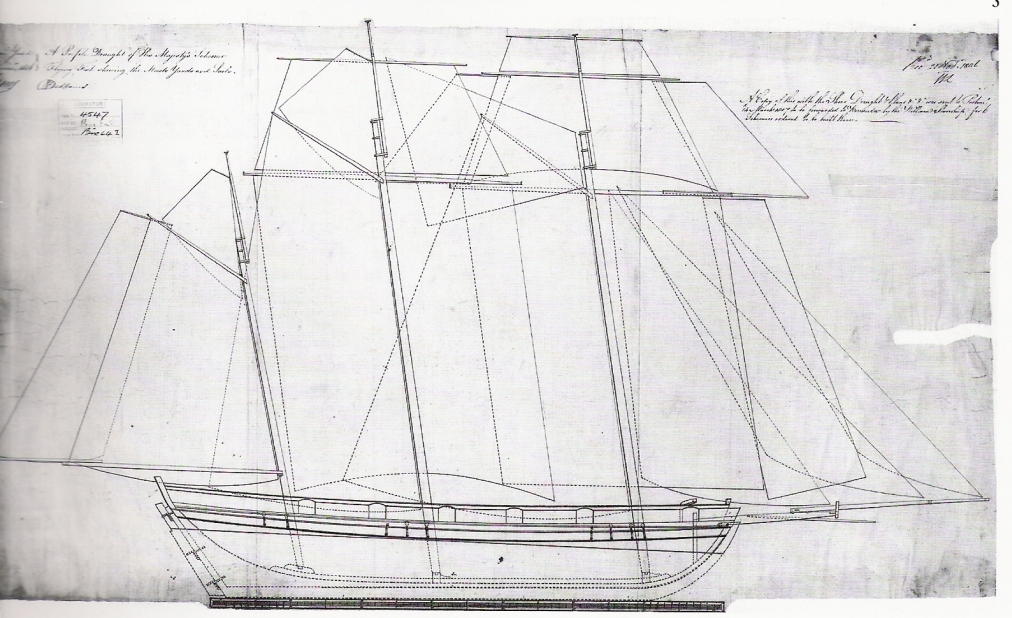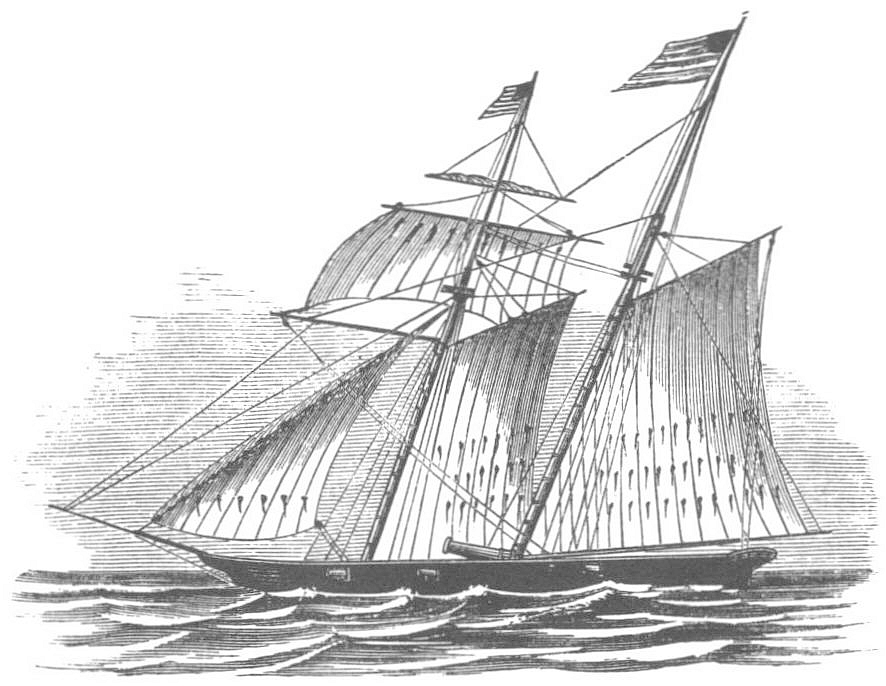Baltimore Clipper on:
[Wikipedia]
[Google]
[Amazon]
 A Baltimore clipper is a fast
A Baltimore clipper is a fast
 They were especially suited to moving low-density, high value perishable cargoes such as
They were especially suited to moving low-density, high value perishable cargoes such as 
 A Baltimore clipper is a fast
A Baltimore clipper is a fast sailing ship
A sailing ship is a sea-going vessel that uses sails mounted on Mast (sailing), masts to harness the power of wind and propel the vessel. There is a variety of sail plans that propel sailing ships, employing Square rig, square-rigged or Fore-an ...
historically built on the mid-Atlantic seaboard of the United States
The United States of America (USA), also known as the United States (U.S.) or America, is a country primarily located in North America. It is a federal republic of 50 U.S. state, states and a federal capital district, Washington, D.C. The 48 ...
, especially at the port of Baltimore
Baltimore is the most populous city in the U.S. state of Maryland. With a population of 585,708 at the 2020 census and estimated at 568,271 in 2024, it is the 30th-most populous U.S. city. The Baltimore metropolitan area is the 20th-large ...
, Maryland
Maryland ( ) is a U.S. state, state in the Mid-Atlantic (United States), Mid-Atlantic region of the United States. It borders the states of Virginia to its south, West Virginia to its west, Pennsylvania to its north, and Delaware to its east ...
. An early form of clipper, the name is most commonly applied to two-masted schooners and brigantine
A brigantine is a two-masted sailing vessel with a fully square-rigged foremast and at least two sails on the main mast: a square topsail and a gaff sail mainsail (behind the mast). The main mast is the second and taller of the two masts.
Ol ...
s. These vessels may also be referred to as Baltimore Flyers.
History
Baltimore clippers were built as small, fast sailing vessels for trade around the coastlines of the United States and with the Caribbean Islands. Their hull lines tended to be very sharp, with a V-shaped cross section below the waterline and strongly raked stem, stern posts, and masts.Gardiner 1999 The origins of the type are unknown, but certainly hulls conforming to the concept were being built inJamaica
Jamaica is an island country in the Caribbean Sea and the West Indies. At , it is the third-largest island—after Cuba and Hispaniola—of the Greater Antilles and the Caribbean. Jamaica lies about south of Cuba, west of Hispaniola (the is ...
and Bermuda
Bermuda is a British Overseas Territories, British Overseas Territory in the Atlantic Ocean, North Atlantic Ocean. The closest land outside the territory is in the American state of North Carolina, about to the west-northwest.
Bermuda is an ...
, with the hull of the ocean-going Bermuda sloop broader than the Jamaican and deeper than the American design. By the late 18th century, the Baltimore configuration was not only popular in the United States as merchant craft, but also in Britain.
The National Maritime Museum, Greenwich, has a one-page drawing labeled "A DRAWING OF HIS MAJESTY'S ARM'D SCHOONER BERBICE, THE 5TH AUG 1789" that comprises a sheer plan, body lines, deck plan, lines, and a view of her stern. These drawings of represent the earliest draught of what became known as the Baltimore clipper.
The Royal Navy found the schooners of only limited usefulness during the French Revolutionary Wars
The French Revolutionary Wars () were a series of sweeping military conflicts resulting from the French Revolution that lasted from 1792 until 1802. They pitted French First Republic, France against Kingdom of Great Britain, Great Britain, Habsb ...
and Napoleonic Wars
{{Infobox military conflict
, conflict = Napoleonic Wars
, partof = the French Revolutionary and Napoleonic Wars
, image = Napoleonic Wars (revision).jpg
, caption = Left to right, top to bottom:Battl ...
because they were unstable gun platforms due to their design for extreme speed compared to their size. Furthermore, the schooner rig does not allow sails to be backed, creating a disadvantage in maneuverability in battle. They were adopted after the wars to pursue slave ships.
 They were especially suited to moving low-density, high value perishable cargoes such as
They were especially suited to moving low-density, high value perishable cargoes such as slaves
Slavery is the ownership of a person as property, especially in regards to their labour. Slavery typically involves compulsory work, with the slave's location of work and residence dictated by the party that holds them in bondage. Enslavemen ...
, and in that trade operated as far afield as the west coast of Africa.
Similar merchant vessels were given letters of marque and served as privateers during the War of Independence
Wars of national liberation, also called wars of independence or wars of liberation, are conflicts fought by nations to gain independence. The term is used in conjunction with wars against foreign powers (or at least those perceived as foreign) ...
. During the War of 1812
The War of 1812 was fought by the United States and its allies against the United Kingdom of Great Britain and Ireland, United Kingdom and its allies in North America. It began when the United States United States declaration of war on the Uni ...
, merchant schooners were too small and slow to escape the British blockade, and larger, faster, more heavily armed, purpose-built privateer Baltimore clippers were developed. The most famous of these larger vessels were the privateers '' Chasseur'', '' Prince de Neufchatel'', and '' General Armstrong''. ''Prince de Neufchatel'' resisted an attack by a fourfold numerically superior force in the ships of HMS '' Endymion'' and ''Chasseur'' alone captured more enemy ships than the entire US Navy during the war. Nevertheless, most privateers during the war were of the smaller type and served as merchant ships despite being given letters of marque. As a result, more privateers were taken by the British blockade of 1813 than ever took a prize themselves.
While the Baltimore clipper's design had flaws, the biggest cause of its decline was public backlash to their functions, such as illegally importing slaves after the Act Prohibiting Importation of Slaves in 1807 and raiding in South America.
One particularly famous Baltimore clipper, and one of the last of the type in commercial service, was the schooner ''Vigilant'' that traded around the Danish Caribbean islands for over a century before sinking in a hurricane
A tropical cyclone is a rapidly rotating storm system with a low-pressure area, a closed low-level atmospheric circulation, strong winds, and a spiral arrangement of thunderstorms that produce heavy rain and squalls. Depending on its ...
on September 12, 1928. She was believed to have been built in the 1790s.

Famous Baltimore clippers
*'' Vigilant'', 1794, one of the first and most famous Baltimore clippers. She sailed for over 130 years, bringing mail and passengers to ports in the Danish West Indies and around the Virgin Islands. *'' Chasseur'' was built in 1812 by Thomas Kemp and commanded by Captain Thomas Boyle, an American privateer during the War of 1812. *''Lynx
A lynx ( ; : lynx or lynxes) is any of the four wikt:extant, extant species (the Canada lynx, Iberian lynx, Eurasian lynx and the bobcat) within the medium-sized wild Felidae, cat genus ''Lynx''. The name originated in Middle Engl ...
'' was built by Thomas Kemp in 1812, also for the War of 1812.
* ', a captured slave ship
Slave ships were large cargo ships specially built or converted from the 17th to the 19th century for transporting Slavery, slaves. Such ships were also known as "Guineamen" because the trade involved human trafficking to and from the Guinea ( ...
, ended up freeing several hundred slaves in service of the West Africa Squadron.
In popular culture
Capt. Jack Aubrey uses a captured Baltimore clipper, the ''Ringle,'' as his tender in thePatrick O'Brian
Patrick O'Brian (12 December 1914 – 2 January 2000), born Richard Patrick Russ, was an English novelist and translator, best known for his Aubrey–Maturin series. These sea novels are set in the Royal Navy during the Napoleonic Wars and ...
novels '' The Commodore'' and '' The Yellow Admiral.'' The ship is named after the American writer who brought the clippers to O'Brian's attention.
Modern replicas
Modern replicas of an early 19th-century Baltimore clipper type include the ill-fated '' Pride of Baltimore'', her replacement, ''Pride of Baltimore II'', '' Californian'', '' La Amistad'', '' Shenandoah'', and the Liberty Clipper and the privateer ''Lynx''.Citations
References
* {{Sailing Vessels and Rigs Vehicles introduced in the 18th century 18th century in Baltimore Merchant sailing ship types +Baltimore Clipper +Baltimore Clipper Transportation in Baltimore Age of Sail ships of the United States Tall ships